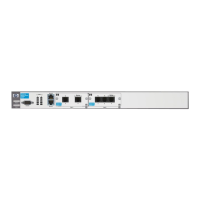12-6
Domain Name System (DNS) Services
Overview
Dynamic DNS
Your device’s IP address may change, and such changes are not always under
your control. For example, your router may receive a dynamic address from
your Internet service provider (ISP). When a device’s address changes, DNS
servers will no longer be able to resolve its hostname, and customers will not
be able to access the device.
In order to map a dynamic IP address with a static hostname, you should
register with an organization that provides dynamic DNS services.
The ProCurve Secure Router supports a client that is compatible with
Dynamic Networking Services, Inc. (www.dyndns.org), or DynDNS. The
client runs on a router interface. It automatically notifies DynDNS whenever
the interface’s IP address changes, and DynDNS propagates the change
throughout its system of DNS servers.
DynDNS provides several types of services:
■ Dynamic DNS
SM
■ Static DNS
SM
■ Custom DNS
SM
Depending on the service you select, you can register a hostname in one of
the domains provided by DynDNS or in your own domain.
Dynamic DNS
Dynamic DNS is a free service that allows you to map dynamic addresses to
up to five hostnames. You must register hostnames in one of 68 set domains.
(See http://www.dyndns.org/services/dns/dyndns/domains.html for a list
of available domains.)
The client running on the ProCurve Secure Router interface automatically
updates DynDNS when the interface’s IP address changes. (If DynDNS does
not receive at least one update every 35 days, it deletes the hostname.)
DynDNS provides five globally redundant DNS servers to ensure that your
hostname will always resolve.
Dynamic DNS is primarily designed for private users. For commercial appli-
cations, you should probably purchase an account upgrade or Custom DNS.

